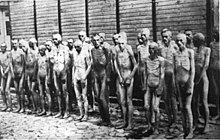Hunger Plan
The Hunger Plan (German: der Hungerplan; der Backe-Plan) was a partially implemented plan developed by Nazi bureaucrats during World War II to seize food from the Soviet Union and give it to German soldiers and civilians. The plan entailed the genocide by starvation of millions of Soviet citizens following Operation Barbarossa, the 1941 invasion of the Soviet Union (see Generalplan Ost). The premise behind the Hunger Plan was that Germany was not self-sufficient in food supplies; to sustain the war and keep up domestic morale, it needed food from conquered lands at any cost. The plan created a famine as an act of policy, killing millions of people.[1]
The Hunger Plan was first formulated by senior German officials during a
Background
Germany in the 1930s, like other European countries, was not self-sufficient and relied on foreign imports to feed its population, a situation worsened with the outbreak of war as the military recruited labourers, requisitioned tractors and horses, and was first priority for fuel. Overall food consumption needed to be reduced. The situation was even worse by 1941, as reserve grain stocks had been consumed and the occupation of large parts of Europe had only worsened the situation, as most of these countries were also net food importers.[6]
German leadership, especially Hitler, was very concerned about the impact of reductions in food consumption on civilian morale. They believed the Allied blockade of Germany during the First World War had been a key cause of Germany's defeat in that war. Thus the preservation of food supplies for Germany itself was considered essential, even at the cost of civilian lives in occupied countries. The combination of German leadership's strong racism against Jews and Soviet civilians and the pressing wartime food crisis proved a deadly combination - the Hunger Plan was based on both practical and ideological needs.[6]
Plan

The architect of the Hunger Plan was Herbert Backe.[1] Together with others, including Heinrich Himmler, Backe led a coalition of Nazi politicians dedicated to securing Germany's food supply. The Hunger Plan may have been decided on almost as soon as Hitler announced his intention to invade the Soviet Union in December 1940. Certainly by 2 May 1941, it was in the advanced stages of planning and was ready for discussion between all the major Nazi state ministries and the Oberkommando der Wehrmacht (OKW) office of economics, headed by General Georg Thomas. The lack of capacity of the Russian railways, the inadequacy of road transport and the shortages of fuel, meant that the German Army would have to feed itself by living off the land in the territories they conquered in the western regions of the Soviet Union.[1]
A meeting on 2 May 1941 between the permanent secretaries responsible for logistical planning for the invasion of the Soviet Union, as well as other high-ranking Nazi Party functionaries, state officials and military officers, included in its conclusions:
1.) The war can only be continued if the entire Wehrmacht is fed from Russia in the third year of the war.
2.) If we take what we need out of the country, there can be no doubt that tens of millions of people will die of starvation.[7]
The minutes of the meeting exemplify German planning for the occupation of the Soviet Union. They present a deliberate decision on the life and death of vast parts of the local population as a logical, inevitable development.[8] Three weeks later, on 23 May 1941, economic policy guidelines for the coming invasion were produced by Hans-Joachim Riecke's agricultural section of the Economic Staff East, which had direct responsibility for the economic and agricultural exploitation of the soon-to-be occupied Soviet territories:
Many tens of millions of people in this country will become superfluous and will die or must emigrate to Siberia. Attempts to rescue the population there from death through starvation by obtaining surpluses from the black earth zone […] prevent the possibility of Germany holding out till the end of the war.[9]
The perceived grain surpluses of
- annihilation of what the German regime perceived as a superfluous population (Jews, and the population of Ukrainian large cities such as Kiev, which received no supplies at all);[12]
- extreme reduction of rations for Ukrainians in the remaining cities; and
- reduction in foodstuffs consumed by the farming population.[1]
- creation of a northern grain deficit zone and southern grain surplus zone in the USSR. The southern surplus zone, where Ukraine was, would produce surpluses of grain that would be sent to the Reich. The northern zone, where the cities and industrial centers were, would starve.[13]
Discussing the plan, Backe noted a "surplus population" in Russia of 20 to 30 million. If that population were cut off from food, it could be used for the invading German Army and the German population.
Effects of the plan
The Hunger Plan caused the deaths of millions of citizens in the German-occupied territories of the Soviet Union.

The most reliable figures for the death rate among Soviet prisoners of war in German captivity reveal that 3.3 million died of a total of 5.7 million captured between June 1941 and February 1945, most of them directly or indirectly from starvation.[20] Of these 3.3 million, 2 million had already died by the beginning of February 1942.[21] The enormous number of deaths was the result of a deliberate policy of starvation directed against Soviet POWs. The German planning staffs had reckoned on capturing and thus having to feed up to two million prisoners within the first eight weeks of the war, i.e. roughly the same number as during the Battle of France in 1940.[22] The number of French, Belgian and Dutch POWs who died in German captivity was extremely low compared with deaths among Soviet POWs.
By the end of 1941, plans to starve the entire civilian population of some areas had been abandoned, due to the failure of the German military campaign
Starvation in other German-occupied territories
The Hunger Plan directed against the population of Soviet cities and grain-deficit territories was unique—the Nazis formulated no similar plan against the inhabitants of other German-occupied territories.
By mid-1941 the German minority in Poland received 2,613 kilocalories (10,930 kJ) per day, while Poles received 699 kilocalories (2,920 kJ) and Jews in the ghetto 184 kilocalories (770 kJ).[29] The Jewish ration supplied a mere 7.5 percent of human daily needs; Polish rations only 26 percent. Only the rations allocated to Germans fulfilled the full needs of their daily caloric intake.[30]
See also
- Drang nach Osten
- Effect of the Siege of Leningrad on the city
- Final Solution
- Generalplan Ost
- Extermination of Soviet prisoners of war by Nazi Germany
- German war crimes
- The Holocaust
- Holodomor
- Lebensraum
- New Order (Nazism)
- Pacte de Famine
- Racial policy of Nazi Germany
- War crimes of the Wehrmacht
References
- ^ a b c d e f g Tooze 2006, pp. 476–485, 538–549.
- ^ Masiuk, Tony (20 March 2019). "Hitler's Manifest Destiny: Nazi Genocide, Slavery, and Colonization in Slavic Eastern Europe". Academia.edu. Archived from the original on 14 March 2022.
- JSTOR 30036414– via JSTOR.
- LCCN 2023940036.
- ^ Masiuk, Tony (20 March 2019). "Hitler's Manifest Destiny: Nazi Genocide, Slavery, and Colonization in Slavic Eastern Europe". Academia.edu. Archived from the original on 14 March 2022.
- ^ ISBN 9780521880787.
- ^ Nbg. Doc. 2718–PS, Aktennotiz über Ergebnis der heutigen Besprechung mit den Staatssekretären über Barbarossa, 2 May 1941, printed in International Military Tribunal, ed.,'Der Prozess gegen die Hauptkriegsverbrecher vor dem Internationalen Militärgerichtshof Nürnberg, 14. November 1945–1. Oktober 1946, vol. 31. Sekretariat des Gerichtshofs, Nuremberg 1948, p. 84.
- ISBN 0-8032-1327-1, p. 235
- ^ Kay 2006a, p. 134.
- ^ Gerhard 2009, p. 56.
- ^ Tooze 2006, p. 476–485 and 538–549.
- ^ On Kiev, see Berkhoff, Karel C. (2004). Harvest of Despair: Life and Death in Ukraine under Nazi Rule. Cambridge: Harvard University Press. pp. 164–186.
- ISBN 978-1-250-00083-5.
- ^ Kay 2006a, pp. 133–139.
- ^ Gerhard 2009, p. 46.
- ^ Snyder, Timothy (21 October 2010). "The Reich's Forgotten Atrocity". The Guardian.
- ^ Snyder, Timothy (2010). Bloodlands: Europe between Hitler and Stalin. New York: Basic Books. p. 411.
- ^ Tooze 2006, p. 482-483.
- ^ Tooze 2006, p. 482.
- ^ Christian Streit: Keine Kameraden: Die Wehrmacht und die sowjetischen Kriegsgefangenen, 1941–1945, 4th rev. ed. Dietz, Bonn 1997, pp. 128–190 and 244–253, esp. 244–246; Christian Gerlach: Kalkulierte Morde: Die deutsche Wirtschafts- und Vernichtungspolitik in Weißrußland, 1941 bis 1944. Hamburger Edition, Hamburg 1999, pp. 788–855 (for Belarus).
- ^ Streit: Keine Kameraden, pp. 128 and 357, note 5.
- ^ Streit: Keine Kameraden, p. 76; Alex J. Kay: "Ausbeutung, Umsiedlung, Massenmord. Die NS-Zukunftspläne für den Osten: Hungerplan und Generalplan Ost", in: Predigthilfe und Materialien für die Gemeinde, Ökumenische Friedensdekade 2012, pp. 44–50, here pp. 47-48.
- ^ On the Leningrad blockade see Alex J. Kay: "Hungertod nach Plan". In: Der Freitag, 23 January 2009, p. 11.
- ISBN 978-1118294789.
- ISBN 0802083900.
- ^ Gerhard 2009.
- ^ Hilberg 1961, p. 173.
- S2CID 145169282.
- ISBN 978-0-19-506285-4. Retrieved 25 January 2008.
- ^ "Ghetto" (PDF). Jerusalem: Yad Vashem.
Bibliography
- Wigbert Benz: Der Hungerplan im "Unternehmen Barbarossa" 1941. Wissenschaftlicher Verlag Berlin, Berlin 2011, ISBN 978-3-86573-613-0.
- ISBN 0-8032-1327-1.
- Lizzie Collingham: The Taste of War: World War Two and the Battle for Food. Allen Lane, 2011, ISBN 978-0-7139-9964-8.
- Gerhard, Gesine (2009). "Food and Genocide: Nazi Agrarian Politics in the Occupied Territories of the Soviet Union". Contemporary European History. 18 (1): 45–65. S2CID 155045613. Retrieved 7 June 2015.
- ISBN 3-930908-54-9.
- Hilberg, Raul (1961). The Destruction of the European Jews. Chicago: Quadrangle Books. OCLC 802965224.
- ISBN 1-84545-186-4.
- S2CID 145055706.
- doi:10.3726/84531_81.
- Alex J. Kay: "'The Purpose of the Russian Campaign is the Decimation of the Slavic Population by Thirty Million': The Radicalization of German Food Policy in early 1941", in: Alex J. Kay, Jeff Rutherford and ISBN 978-1-58046-407-9, pp. 101–129.
- ISBN 978-0-224-08141-2, pp. xiv, 162–188, 411.
- ISBN 0-670-03826-1.
- Cesarean, David. Final Solution: The Fate of the Jews 1933-1949

